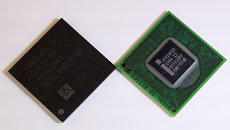- Joined
- Oct 9, 2007
- Messages
- 47,684 (7.42/day)
- Location
- Dublin, Ireland
| System Name | RBMK-1000 |
|---|---|
| Processor | AMD Ryzen 7 5700G |
| Motherboard | Gigabyte B550 AORUS Elite V2 |
| Cooling | DeepCool Gammax L240 V2 |
| Memory | 2x 16GB DDR4-3200 |
| Video Card(s) | Galax RTX 4070 Ti EX |
| Storage | Samsung 990 1TB |
| Display(s) | BenQ 1440p 60 Hz 27-inch |
| Case | Corsair Carbide 100R |
| Audio Device(s) | ASUS SupremeFX S1220A |
| Power Supply | Cooler Master MWE Gold 650W |
| Mouse | ASUS ROG Strix Impact |
| Keyboard | Gamdias Hermes E2 |
| Software | Windows 11 Pro |
Benefitting from the company's power-saving architecture, transistor and circuit design expertise, plus unique manufacturing process techniques, Intel Corporation today unveiled its newest Intel Atom processor-based platform (formerly "Moorestown").
The technology package provides significantly lower power consumption and prepares the company to target a range of computing devices, including high-end smartphones, tablets and other mobile handheld products. The chips bring Intel's classic product strengths - outstanding performance to run a comprehensive and growing number of rich media and Internet applications, a choice of software, and the ability to easily multitask - across a number of applications, including HD video and multi-point videoconferencing.



"Intel has delivered its first product that is opening the door for Intel Architecture [IA] in the smartphone market segment," said Anand Chandrasekher, Intel senior vice president and general manager of the Ultra Mobility Group. "Through "Moorestown," Intel is scaling the benefits of IA while significantly reducing the power, cost and footprint to better address handheld market segments. As a result of our efforts, the Intel Atom processor is pushing the boundaries of higher performance at significantly lower power to show what's possible as handheld devices become small, powerful mobile computers."
Architected for Low Power and Industry Leading Performance
The platform includes the Intel Atom Processor Z6xx Series Family (formerly "Lincroft" system-on-chip [SoC]), the Intel Platform Controller Hub MP20 (formerly "Langwell") and a dedicated Mixed Signal IC (MSIC), formerly "Briertown."
The platform has been repartitioned to include the Intel Atom Processor Z6xx, which combines the 45nm Intel Atom processor core with 3-D graphics, video encode and decode, as well as memory and display controllers into a single SoC design. It also includes the MP20 Platform Controller Hub which supports a range of system-level functions and I/O blocks. Additionally, a dedicated MSIC integrates power delivery and battery charging, and consolidates a range of analog and digital components.
Collectively these new chips deliver significantly lower power including >50x reduction in idle power, >20x reduction in audio power, and 2-3x reductions across browsing and video scenarios - all at the platform level when compared to Intel's previous-generation product1. These power savings translate into >10 days of standby, up to 2 days of audio playback and 4-5 hours of browsing and video battery life3. When combined with 1.5-3x higher compute performance, 2-4x richer graphics, >4x higher JavaScript performance, and support for full HD 1080p high-profile video decoding and 720p HD video recording, these low-power innovations bring a rich, PC-like visual experience to powerful handheld computers.
Building on the C6 state in the original Intel Atom processor design, the SoC incorporates new ultra-low-power states (S0i1 and S0i3), which take the SoC to 100 micro-watts. At the platform level, Intel implemented a new, fine grain OS power management approach that manages the idle and active power states across all aspects of the system based on usage scenarios. This software-managed technique applies aggressive power and clock gating across the SoC's power islands and system voltage rails. Additionally, Intel used a new high-K 45 nm LP SOI process to support a multiple transistor design with a range of high-voltage I/Os.
These power management capabilities, when combined with Intel Burst Performance Technology for high-performance on demand, and Intel's Bus Turbo Mode for high-bandwidth on demand, help to deliver industry leading performance and power efficiency across a range of handheld devices.
"After we delivered the first-generation Intel Atom processor with 10x thermal power reduction, we challenged ourselves to achieve 50x power reduction at the platform level," said Belli Kuttanna, chief Intel Atom processor architect. "We are delighted to have exceeded this goal while increasing performance and are proud of the architects and designers who consistently reinvent the possibilities of Intel Architecture."
Availability
The Intel Atom Processor Z6xx Series Family, Intel Platform Controller Hub MP20 and the dedicated Mixed Signal IC are available today.
The new platform supports a range of scalable frequencies, up to 1.5 GHz for high-end smartphones and up to 1.9 GHz for tablets and other handheld designs. The chips also bring support for Wi-Fi, 3G/HSPA, and WiMAX, as well as a range of operation systems, including Android, Meego and Moblin. Intel is bringing together a breadth of applications and ecosystem support across these platforms to enable a software- and Internet-compatible user experience for developers and consumers.
HIGHLIGHTS
View at TechPowerUp Main Site
The technology package provides significantly lower power consumption and prepares the company to target a range of computing devices, including high-end smartphones, tablets and other mobile handheld products. The chips bring Intel's classic product strengths - outstanding performance to run a comprehensive and growing number of rich media and Internet applications, a choice of software, and the ability to easily multitask - across a number of applications, including HD video and multi-point videoconferencing.



"Intel has delivered its first product that is opening the door for Intel Architecture [IA] in the smartphone market segment," said Anand Chandrasekher, Intel senior vice president and general manager of the Ultra Mobility Group. "Through "Moorestown," Intel is scaling the benefits of IA while significantly reducing the power, cost and footprint to better address handheld market segments. As a result of our efforts, the Intel Atom processor is pushing the boundaries of higher performance at significantly lower power to show what's possible as handheld devices become small, powerful mobile computers."
Architected for Low Power and Industry Leading Performance
The platform includes the Intel Atom Processor Z6xx Series Family (formerly "Lincroft" system-on-chip [SoC]), the Intel Platform Controller Hub MP20 (formerly "Langwell") and a dedicated Mixed Signal IC (MSIC), formerly "Briertown."
The platform has been repartitioned to include the Intel Atom Processor Z6xx, which combines the 45nm Intel Atom processor core with 3-D graphics, video encode and decode, as well as memory and display controllers into a single SoC design. It also includes the MP20 Platform Controller Hub which supports a range of system-level functions and I/O blocks. Additionally, a dedicated MSIC integrates power delivery and battery charging, and consolidates a range of analog and digital components.
Collectively these new chips deliver significantly lower power including >50x reduction in idle power, >20x reduction in audio power, and 2-3x reductions across browsing and video scenarios - all at the platform level when compared to Intel's previous-generation product1. These power savings translate into >10 days of standby, up to 2 days of audio playback and 4-5 hours of browsing and video battery life3. When combined with 1.5-3x higher compute performance, 2-4x richer graphics, >4x higher JavaScript performance, and support for full HD 1080p high-profile video decoding and 720p HD video recording, these low-power innovations bring a rich, PC-like visual experience to powerful handheld computers.
Building on the C6 state in the original Intel Atom processor design, the SoC incorporates new ultra-low-power states (S0i1 and S0i3), which take the SoC to 100 micro-watts. At the platform level, Intel implemented a new, fine grain OS power management approach that manages the idle and active power states across all aspects of the system based on usage scenarios. This software-managed technique applies aggressive power and clock gating across the SoC's power islands and system voltage rails. Additionally, Intel used a new high-K 45 nm LP SOI process to support a multiple transistor design with a range of high-voltage I/Os.
These power management capabilities, when combined with Intel Burst Performance Technology for high-performance on demand, and Intel's Bus Turbo Mode for high-bandwidth on demand, help to deliver industry leading performance and power efficiency across a range of handheld devices.
"After we delivered the first-generation Intel Atom processor with 10x thermal power reduction, we challenged ourselves to achieve 50x power reduction at the platform level," said Belli Kuttanna, chief Intel Atom processor architect. "We are delighted to have exceeded this goal while increasing performance and are proud of the architects and designers who consistently reinvent the possibilities of Intel Architecture."
Availability
The Intel Atom Processor Z6xx Series Family, Intel Platform Controller Hub MP20 and the dedicated Mixed Signal IC are available today.
The new platform supports a range of scalable frequencies, up to 1.5 GHz for high-end smartphones and up to 1.9 GHz for tablets and other handheld designs. The chips also bring support for Wi-Fi, 3G/HSPA, and WiMAX, as well as a range of operation systems, including Android, Meego and Moblin. Intel is bringing together a breadth of applications and ecosystem support across these platforms to enable a software- and Internet-compatible user experience for developers and consumers.
HIGHLIGHTS
- Based on Intel's leading silicon technology and manufacturing capabilities, chips deliver >50x platform idle power reduction while increasing performance and reducing size1.
- Platform brings unlimited "PC-like" experience with fast Internet, multi-tasking, full 1080p video, 3-D graphics, multi-point videoconferencing and voice in pocketable designs.
- New Intel Atom Processor Z6xx based on Intel's new 45nm low-power process, packs 140 million transistors into the SoC. The platform also includes a Controller Hub (MP20) and a dedicated Mixed Signal IC.
- Highly integrated platform capable of scaling a range of operating systems and market segments including high-end smartphones, tablets and handheld devices.
View at TechPowerUp Main Site







